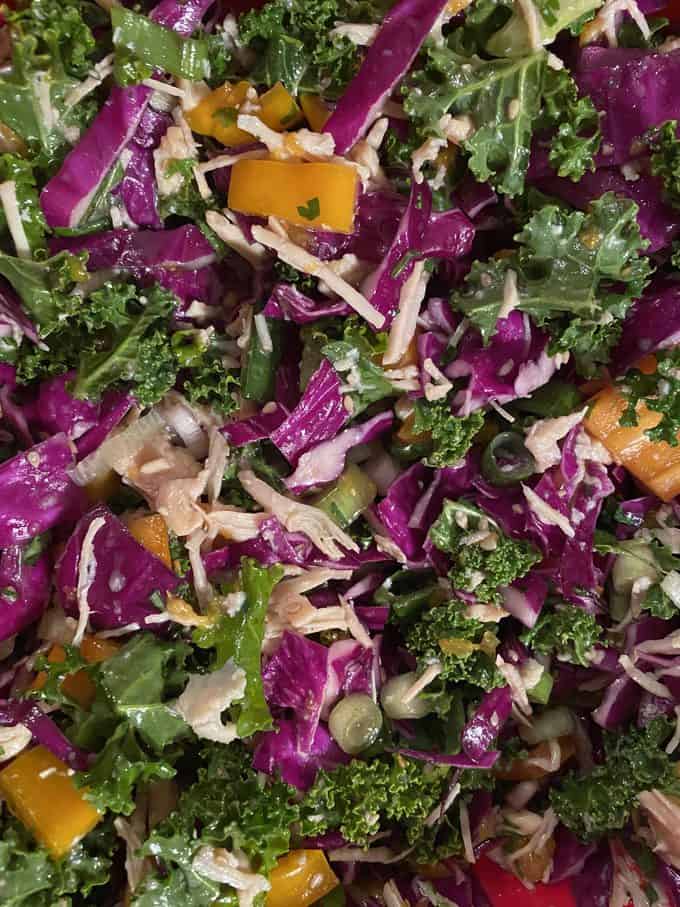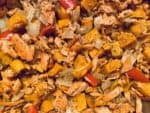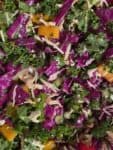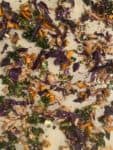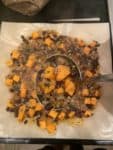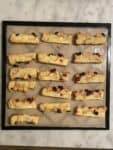Differences in Dehydrators
There are two different styles of dehydrators. One has a round shape and the other is shaped like a box. There are differences in the way they work and they each have their pros and cons.
Round Dehydrators
Round dehydrators have a fan on the bottom that circulates air vertically across the food trays. Nesco is a popular brand of this type of dehydrator.
Pros of round dehydrators are:
- Less expensive
- More compact and easier to store, usually
- More trays can be added to certain models if you need more space
Cons of round dehydrators are:
- Not as much surface area/drying room as a box dehydrator
If you purchase a round dehydrator, make sure there is a screen covering the fan at the bottom of the unit, to avoid food and debris falling into the motor.
Box Dehydrators
Box dehydrators have a motor and fan at the back of the unit. The air circulates horizontally across the food trays.
Pros of box dehydrators:
- More surface area which means you can dry more food at one time
- Air tends to circulate against food more evenly compared to round dehydrators
Cons of box dehydrators
- More expensive
- They can get quite large and be more challenging to store
I personally own a box dehydrator, this 9-tray Excalibur and I used to own a round one. I upgraded because I wanted something bigger for my family of five people.
Both styles of dehydrators make a humming noise when they’re on. It’s not overly loud, but it’s also not whisper quiet. If you’re not super sensitive to extraneous noise, it shouldn’t bother you that much. It’s definitely a white noise and doesn’t change in pitch or frequency.
Benefits of Dehydrating Food for Hiking
There are a myriad of benefits for dehydrating food for hiking. Each person will probably come up with a different list of benefits, but the following are the reasons I do it.
Cost
With my family of five, it can cost upwards of $50-$60 for one commercially prepared dehydrated dinner for all of us! If I dehydrate a comparable meal at home, I likely spend a third to a half of that amount (and even lower if it’s something with inexpensive ingredients). It didn’t take me long to pay off my dehydrator with those cost savings! Even is no one else backpacked in my family, I would still have paid it off years ago with the cost savings.
Customized Meals and Portions
Since I am often creating meals for five people, it’s important to make things that I know we’ll all like. Dehydrating food allows me to tailor what I make to all of our taste buds.
I also like that I can customize the portions of meals I dehydrate. If I’m pulling a meal from my stash for a short overnight trip, I may not bring as big of a portion as I would on a more strenuous, high mileage trip.
Dehydrating meals is also incredibly helpful for people who are trying to adhere to certain diets (Paleo, gluten free, vegan, etc).
Health and Nutrition
Commercially prepared backpacking meals have come a long way since the early days. There are so many cottage gear companies that create fantastic meals these days (and even Mountain House has come a long way) My personal favorite is Food for the Sole.
That being said, there are still plenty of companies that aren’t doing as good of a job as Food for the Sole, and it’s nice to have the option to create meals comparable to their quality at home.
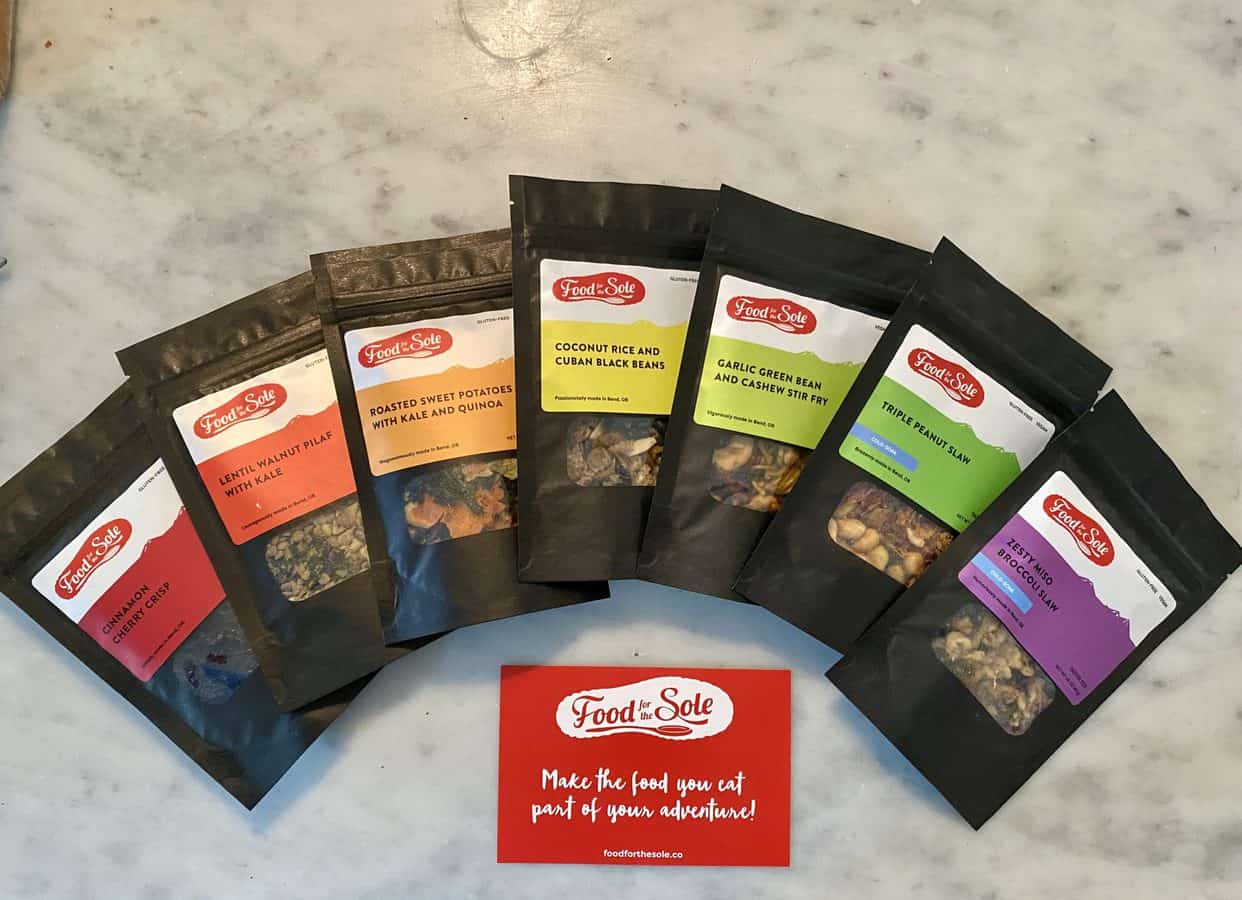
Food for the Sole’s meals are all fantastic!
In addition to all the above reasons, I personally think it’s a heck of a lot of fun to dehydrate my meals! I love watching the transformation of a freshly made recipe into a dried version. The best and most rewarding part, however, is watching it turn from a dehydrated state to something delicious and nourishing after a long day on the trail!
My Favorite Resources for Dehydrating Food
Eventually, you’ll get a feel for what types of recipes can be dehydrated and which ones don’t translate so well into a dried state. It just takes practice and experience. Until you gain that knowledge (and even when you do have a good feel for it), I think it’s wise to have a couple of resources on hand to pull recipes and information from, specific to hiking and backpacking meals.
Online Resources
Judy Gross, the owner of Lightheart Gear, has an excellent Facebook Group called Dehydrating Backpacking Food. It’s a private group and Judy won’t let you in unless you answer her required questions when you request to join (they’re easy and simply a spam screening method). Many folks in her group are very knowledgeable and experienced with dehydrating food, and there is a collection of recipes in the files of the group as well.
Speaking of Judy, here’s an excellent podcast where she was recorded speaking about dehydrating to a group of hikers at the A.T. kick off event at Amicalola Falls.
Backpacking Meal Planning for Thru Hikers isn’t specific to dehydrating food, but it’s still a great resource for DIY trail food.
Fresh off the Grid is another favorite website. They have lots of recipes on their site and not all are specific to dehydrating, but there are enough to include them on this list.
Backpacking Chef is an excellent website to learn more about the basics of dehydrating food and to find lots of recipes to get started. The associated cookbook that Chef Glenn, the website’s author, Recipes for Adventure wrote is considered one of the best resources out there for dehydrated backpacking food.
Speaking of cookbooks, let’s move on to a few of my favorites.
My Favorite Dehydrator Cookbooks
The Dehydrator Cookbook for Outdoor Adventurers has become my newest favorite resource for healthy and delicious meals to dehydrate. This book is authored by Julie Mosier, one of the two founders of Food for the Sole. It has recipes for every breakfast, snacks, lunch, dinner and dessert (including a chocolate cherry bread pudding recipe which is da bomb)!
I especially love that the book includes cold soak recipes (that don’t suck) for salads such as Sesame Ginger Kale Slaw. So good (and incredibly healthy)!
Here are some photos of a few recipes I’ve made from this cookbook (click on any photo to be taken to a larger image). They’re all excellent!
- Salmon Roasted Sweet Potato Hash, pre dehydration
- Sesame Ginger Kale Slaw, pre dehydration
- Chocolate and Cherry Bread Pudding
- Sesame Ginger Kale Slaw, dehydrated
- Spicy Sweet Potato and Chorizo Stew, pre dehydration
- Bread pudding slices
Recipes for Adventure is another favorite. Chef Glenn’s book is a bit different from Mosier’s as he dehydrates individual ingredients and then combines them to create a meal, versus making a recipe and dehydrating it in its entirety. I personally think the flavors probably meld a bit better when you dehydrate a full recipe, but that’s just my opinion and it doesn’t seem to matter anyway since these recipes are fantastic.
This cookbook is a staple for excellent backpacking meals you can make at home with a dehydrator.
Backpack Gourmet was the first cookbook I bought for dehydrating backpacking meals, and it’s still one I use often. I’ve yet to make a dud from it and I’ve made quite a bit over the years. Her breakfast casseroles in particular are unique and different than anything I’ve seen in other cookbooks. The salmon jerky is spectacular as are any of the pasta dishes. I love this cookbook and it will remain a favorite for years to come.
There are many more cookbooks that pertain to dehydrating food for the trail, but these are just the ones I own (and love).
Other Equipment for Dehydrating
While none of these items are imperative to start dehydrating, they make the experience easier and more enjoyable.
Teflon Sheets
Teflon sheets are the one thing on this list that is practically a non negotiable, in my opinion. If you’re going to dehydrate anything runny, like a stew or soup, you need these if you own an Excalibur Dehydrator. The trays that come with the dehydrator have a mesh insert only, hence the need for sheets like this. Nothing works like these do (saran wrap, parchment, foil don’t work well). They’re inexpensive and last forever if you take care of them.
Kitchen Scale
I can’t imagine not having a kitchen scale and I use mine every single day. For dehydrating foods and planning my quantity of food for backpacking trips, it’s invaluable. I’ve owned this Oxo Kitchen Scale for years and it has never let me down.
Ziploc Freezer Bags
Ziploc Freezer Bags are another dehydrating staple. Whenever I make a recipe, I either parcel out the ingredients into individual servings or put the entire recipe in a bag and pull out a certain amount of it as needed (this is the more common scenario).
Blender
Certain foods, like sour cream or yogurt, dehydrate better if they’re blended up into a powder versus rehydrated in pieces. And yes, you can dehydrate sour cream and yogurt! I love adding pureed fruit (in my blender) to plain yogurt and dehydrating it. I then add it to Muesli (I like the one Trader Joe’s carries) and rehydrate it. It’s one of my favorite cold breakfasts on the trail and it wouldn’t be nearly as easy to create without my blender.
I have a Blendtec Blender and it has lasted for years. They’re extremely durable and workhorses in the kitchen, if you use a blender often.
Simple Foods to Dehydrate
The following are some of my favorite single ingredients to dehydrate and either eat on their own as a snack or add to recipes.
- Watermelon: It’s delicious dehydrated!
- Apples: I typically sprinkle these with a little cinnamon and they’re my all-time favorite snack on the trail. They really are better than any store bought dried apple–much more apple flavor and the cinnamon really makes them extra yummy.
- Pineapple is my most favorite fruit to dehydrate. It’s delicious and far superior to dried pineapple you buy in the store.
- Spinach can be dehydrated in its fresh state. Just throw the leaves on the trays and let ’em go! They make a great addition to meals you assemble out of dehydrated ingredients, and I’ve thrown them in my “ramen bombs” before. You can make it into a powder as well.
- Hummus is super easy to dehydrate. Just spread it out on the trays (with teflon sheets on top of the mesh) and let it go. I typically take the lazy route with hummus and just use my favorite store bought brand, but The Dehydrator Cookbook for Outdoor Adventurers has a great recipe for it.
- Veggies from my garden: If you’re like me and over plant in your garden, a dehydrator will quickly put your excess to good use. It’s so nice to have a collection of dried veggies to add to simple meals on the trail to give them a bit more nutritional value. And zucchini chips are the bomb.
- Smoothies. Judy Gross taught me this trick in the podcast I mentioned above. Her recipes for smoothies can be found in her Facebook group and I think it’s such a clever idea for a nutritious treat on the trail, especially if you add quality, whole food ingredients to it.
Dehydrating Leftovers
One of my favorite things to do with leftovers is dehydrate them! It takes a bit of experience to figure out which recipes will work well for this purpose. Soups, stews, and casseroles are the best choices.
Most sources will try to steer you away from dehydrating something like lasagna because of the cheese content, but the cookbook Backpack Gourmet quickly convinced me that it’s ok (her recipe is excellent, by the way) and one of the most delicious things I eat in the backcountry! Fats like cheese won’t dehydrate, so the texture is a little weird when it’s finished drying, but it all rehydrates beautifully.
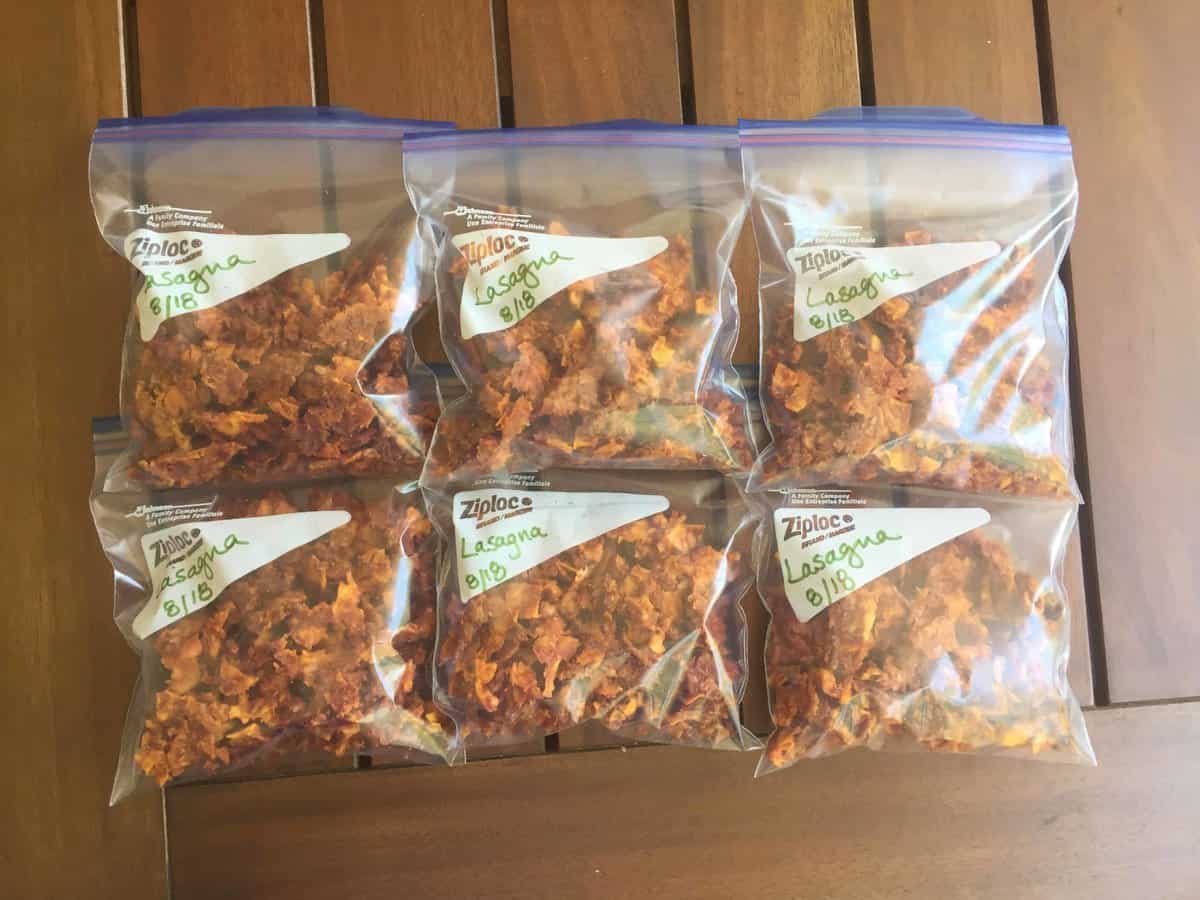
Homemade lasagna packaged up for the family and ready to pull from the freezer when I need it!
With casseroles, make sure to cut the food into small pieces before putting it on the trays. Pretend you’re cutting it for a toddler and you’ll be in the right size range. You want as much surface area as possible exposed to the air from the fan. Don’t be afraid to experiment once you get the hang of the basics!
Storing Dehydrated Meals
I store my meals in the freezer, so I don’t worry nearly as much about dehydrating foods with fats that might go rancid, like cheese or oils. A “frost free” freezer is probably best for long term storage since . It’s fine to store dehydrated meals at room temperature too, but I’d just be more conservative with how long you store them, personally.
One question a lot of folks have is how to gauge the amount of food to use for a meal, Here’s how I do it: If a recipe makes four servings, I weigh the entire contents of the recipe after it’s dehydrated. I divide the weight of the entire recipe by the number of servings, and then I write that amount with a Sharpie on the Ziploc bag. I also label the bag with the following information:
- The date I dehydrated it
- The name of the recipe
- The name of the cookbook or source, if it’s from a cookbook or online (so I’ll know where to go to recreate it, if it’s awesome)

A full recipe with 4 servings fit in this quart size Ziploc!
Another way to dial in portion sizes for each meal is to make your recipe, but before you dehydrate it, dish out a serving size into a bowl. Put that amount on one tray of your dehydrator and then package it up in an individual Ziploc bag after its dehydrated.
Using Dehydrated Meals
When I need to use a meal for a backpacking trip, if I’ve stored an entire recipe in one bag, I’ll put the weight of one serving in another Ziploc bag and add boiling water to it in camp. I’ll also write the name of the food and the directions (if there are any) on the bag with a Sharpie. I use a homemade “cozy” around the bag to keep the food warm while it rehydrates, but you can purchase something like this from Antigravity Gear if you’re not a DIY sewing kind of person.
Most recipes from dehydrating themed cookbooks will give you an amount of water to rehydrate a meal with, but I typically just eyeball it. You want to at least barely cover the food for most recipes. I’m usually conservative with how much water I add at first, since I can always add more, but it’s more difficult to take it out.
Conclusion
I hope this has been helpful! It’s probably not hard to tell that I love dehydrating food for hikes and think it’s the best way to cater to your own taste buds and eat healthy foods on the trail (unless you only buy Food for the Sole, which is truly the only commercial food I really crave in the backcountry).
Reach out to me if you have questions–I’m happy to help in any way I can. And if you have additional comments you’d like others to know about dehydrating food, drop them below!
Happy trails,
Nancy “Seal Mom”
